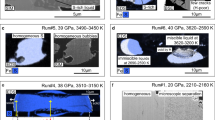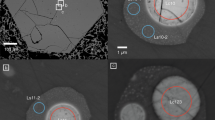Abstract
THE formation of immiscible liquids in silicate melts has been suggested as one of the possible methods by which natural magmas may produce a variety of rock types. This theory has, however, not found much favour among petrologists, because of the lack of observational and experimental evidence. Bowen1 pointed out that direct evidence of this phenomenon, if it existed in rock melts, should be found in glassy lavas such as obsidian; in these lavas would be found discrete spheres of one glass embedded in another glass of different composition. No such phenomena have been observed. Greig2 conducted extensive laboratory investigations on immiscibility in binary and ternary silicate systems. The areas of liquid immiscibility which he found lay well away from those representing even abnormal rock compositions. More recently, however, Roedder3 found an extensive region of low-temperature immiscibility in the system FeO—K2O—A12O3—SiO2. This new region of immiscibility fell much closer to the compositions of some abnormal rock types. Direct evidence of the existence of silicate immiscibility in Nature has still been lacking, however.
This is a preview of subscription content, access via your institution
Access options
Subscribe to this journal
Receive 51 print issues and online access
$199.00 per year
only $3.90 per issue
Buy this article
- Purchase on SpringerLink
- Instant access to full article PDF
Prices may be subject to local taxes which are calculated during checkout
Similar content being viewed by others
References
Bowen, N. L., “The Evolution of Igneous Rocks” (Princeton, 1928).
Grieg, J. W., Amer. J. Sci., 13, 1 and 133 (1927).
Roedder, E. W., Amer. Mineral., 36, 282 (1951).
Barnes, V. E., Univ. of Texas Pub. 3945 (1940).
Author information
Authors and Affiliations
Rights and permissions
About this article
Cite this article
CASSIDY, W., SEGNIT, E. Liquid Immiscibility in a Silicate Melt. Nature 176, 305 (1955). https://doi.org/10.1038/176305a0
Issue Date:
DOI: https://doi.org/10.1038/176305a0



